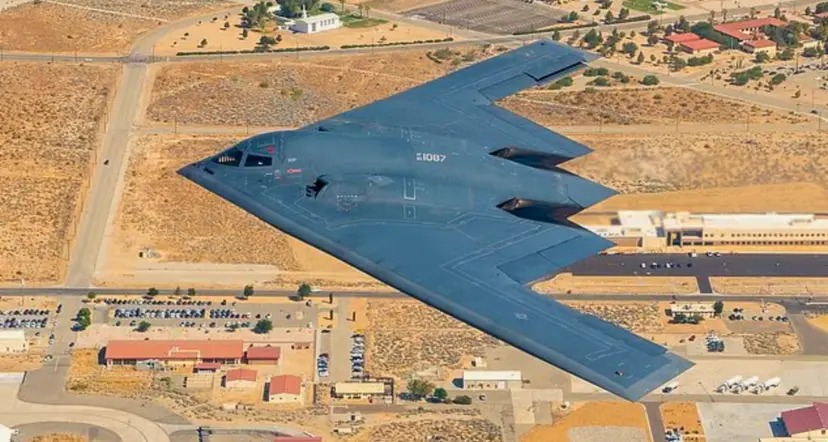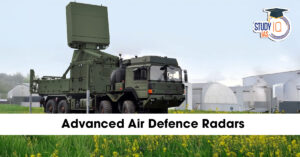Table of Contents
On June 21–22, 2025, the United States Air Force carried out a historic and precision airstrike mission dubbed Operation Midnight Hammer. In one of the most daring and complex missions in recent military history, B-2A Spirit stealth bombers led a 37-hour non-stop round-trip mission to destroy Iran’s most fortified nuclear sites—Fordow, Natanz, and Isfahan.
This mission showcased the unmatched stealth, precision, and payload capacity of the B-2 bombers, along with the combat debut of the powerful GBU-57 Massive Ordnance Penetrator (MOP)—a bunker-busting bomb capable of destroying deeply buried nuclear assets.
US B-2 Bombers
The U.S. conducted a major airstrike on Iran’s underground nuclear sites using B-2 stealth bombers and bunker buster bombs, targeting facilities in Fordow, Natanz, and Isfahan.
| About US B-2 Bombers | |
| Type | U.S. long-range, all-altitude stealth strategic bomber |
| Manufacturer | Northrop Grumman Corporation |
| Cost | Approx. $2.1 billion per unit – the world’s most expensive military aircraft |
| Key Features & Capabilities |
|
What Was Operation Midnight Hammer?
Operation Midnight Hammer was a top-secret U.S. military campaign launched in response to escalating tensions between Iran and Israel. Amid rising fears of Iran crossing the nuclear threshold, the U.S. executed a strategic preemptive strike on Iran’s nuclear infrastructure.
Key Highlights:
- Mission Duration: 37 hours round trip
- Aircraft Involved: 125 U.S. military aircraft, including 7 B-2A Spirits
- Targets: Fordow, Natanz, Isfahan
- Weapons Used: GBU-57 MOP bombs, Tomahawk cruise missiles
- Operation Timeframe: 22:40–23:05 GMT on June 21
How Did B-2 Bombers Play a Key Role?
The B-2 Spirit bomber, known for its stealth capabilities and long-range endurance, was pivotal to Operation Midnight Hammer’s success.
-
Flight Duration: The six B-2 bombers took off from Whiteman Air Force Base, Missouri, flying over 7,000 miles nonstop with multiple mid-air refuelings.
-
Stealth Technology: Equipped with radar-absorbing materials and an ultra-low radar cross-section, the B-2s evaded Iran’s sophisticated air defenses, including Russian-made surface-to-air missile systems.
-
Payload Capacity: Each B-2 could carry up to two Massive Ordnance Penetrators internally, preserving stealth while delivering destructive power.
-
Precision Targeting: Advanced onboard navigation and targeting systems enabled pinpoint strikes on underground hardened facilities.
The Weapons: GBU-57A/B Massive Ordnance Penetrator & Tomahawk Missiles
GBU-57A/B Massive Ordnance Penetrator (MOP)
-
Weight: Approximately 30,000 pounds (13,600 kg).
-
Penetration: Capable of burrowing through up to 200 feet of earth or 60 feet of reinforced concrete before detonating.
-
Purpose: Specifically designed to destroy deep underground bunkers, like the fortified Fordow nuclear site.
-
Operational Use: 14 MOP bombs were dropped on Fordow and Natanz during the strike.
Tomahawk Cruise Missiles
-
Launch Platform: Submarine-launched.
-
Use: Targeted surface and above-ground infrastructure at Natanz and Isfahan.
-
Precision: Renowned for high accuracy and reliability.
Why Target These Sites?
-
Fordow: Situated 300 feet under a mountain and shielded by dense air defenses, Fordow is crucial to Iran’s uranium enrichment capabilities.
-
Natanz: The main facility for uranium enrichment, vital to Iran’s nuclear fuel cycle.
-
Isfahan: Central to uranium conversion and fuel production.
Destroying these sites severely disrupted Iran’s ability to produce enriched uranium, pushing back their nuclear weapons timeline.
Strategic Importance of Operation Midnight Hammer
-
Showcasing U.S. Military Reach: The 37-hour flight demonstrated America’s ability to project power globally with stealth and precision.
-
Demonstrating Technological Superiority: The first-ever combat use of the Massive Ordnance Penetrator highlighted advances in bunker-busting technology.
-
Geopolitical Message: Reinforced U.S. commitment to prevent nuclear proliferation in the Middle East.
-
Avoiding Escalation: Despite the scale, the operation was designed to limit civilian casualties and avoid a broader conflict.
Global Reactions and Future Implications
-
Iran’s Response: Tehran condemned the strikes as violations of international law but reported limited damage and no radiation leaks.
-
International Community: Mixed reactions ranging from support for nuclear non-proliferation to warnings about escalating tensions.
-
Potential Retaliation: Experts warn of possible missile strikes on U.S. bases or disruption of global oil shipping lanes.
-
Diplomatic Fallout: The strikes complicate prospects for renewed negotiations on Iran’s nuclear program.
Conclusion
Operation Midnight Hammer represents a significant chapter in modern military history — blending advanced stealth technology, precision weapons, and strategic planning to target critical nuclear infrastructure halfway across the world. The US B-2 bombers’ role in this mission underscores the evolving nature of aerial warfare and America’s resolve to curb nuclear threats through targeted, high-impact strikes.


 Advanced Air Defence Radars: Types, Comp...
Advanced Air Defence Radars: Types, Comp...
 Ion Chromatography, Working and Applicat...
Ion Chromatography, Working and Applicat...
 Broadly Neutralising Antibodies (bNAbs):...
Broadly Neutralising Antibodies (bNAbs):...




















